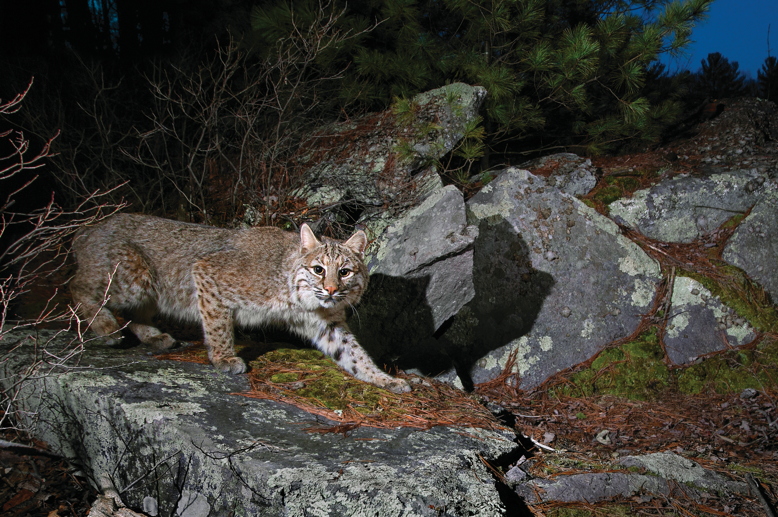
Bobcats sometimes avoid crossing roads, which fracture their habitat. Photo courtesy of Tyler Christensen.
Like the red knot, almost all of New Jersey’s endangered or threatened species face multiple threats. Primary offenders are habitat loss due to destruction of the natural landscape for development and habitat degradation due to pollution and other stressors on land and waterways. Habitat fragmentation—the separation of habitat into smaller units by roads, development and farming—is another major threat. These primary threats are exacerbated by secondary threats, including disease, human disturbance, climate change, invasive species and the illegal pet trade.
New Jersey’s more than 80 threatened or endangered species come in all shapes and sizes, from the 1.5-inch bronze copper butterfly to the 60,000-pound humpback whale.
The very presence of some of Jersey’s listed species might come as a surprise to most residents. Take the bobcat, the last of New Jersey’s big cats. These wild carnivores suffered at the turn of the 20th century when massive destruction of forests for lumber, fuel and charcoal isolated cat populations. Vehicle-caused mortality was another factor in the near extinction of the species in the 1970s. Desperate to keep the cats alive in the Garden State, 24 bobcats from Maine were introduced between 1978 and 1982. While the project appeared successful, the species has been listed as endangered since 1991. Habitat loss and fragmentation and death by automobile continue to take their toll. The shy cats sometimes avoid crossing roadways, further reducing their territory to isolated patches. Scientists are unsure how many remain in the state today.

Blue-spotted salamander. Illustration by Janice Belove.
Many amphibian species, like the endangered blue-spotted salamanders of northern New Jersey, are threatened by continued degradation of habitat due to development and decreased water quality. Roads have split and fragmented their range, leaving isolated populations vulnerable to severe declines and reduced genetic diversity. Some of these amphibians, like the Jefferson salamander, a species of special concern, are potentially subject to 100 percent road mortality in certain areas each spring when they try to reach their breeding grounds, says Kelly Triece, wildlife biologist with CWF.
The endangered northern long-eared bat, whose population has declined by 99 percent over the past decade, suffered drastically due to the spread of white-nose syndrome (WNS)—a disease caused by an invasive fungus.
READ MORE: New Jersey’s native bat species are struggling after an invasive fungus attack.
Invasive species—like the fungus causing WNS or the European starling, an invasive bird introduced to the United States by Shakespeare enthusiasts in the 19th century—can spread disease among native plants and animals and can also outcompete indigenous species for habitat and food.
Pollution affects several endangered species, including the Atlantic sturgeon and the bog turtle. Listed species like the bog turtle and timber rattlesnake, are also decreasing in the wild in part because of their value in the pet trade.
Native species that are thriving can also do damage to listed species. Predator species like red fox and raccoons that thrive around human populations are threats to vulnerable species like the endangered piping plover and other beach-nesting shore birds.
“Red foxes are good at getting handouts, they’re good at finding food, so their populations are arguably higher than natural levels,” says Jenkins. “So in turn, they prey on piping plovers.”

Horseshoe crabs pile up on the Delaware Bay beaches in New Jersey to breed each spring. Photo by Steve Greer.
The threats continue to mount, but funding for the state agencies responsible for protecting vulnerable wildlife is limited. The ENSP—the state program charged with protecting New Jersey’s endangered and threatened wildlife under the New Jersey Endangered and Nongame Species Conservation Act (ENSCA) of 1973—has a budget of just $2.5 million to cover its 14-person staff and all its projects. ENSP must protect and manage the state’s nearly 500 wildlife species—including those that are endangered or threatened.
The funds are cobbled together mainly from federal aid, including State Wildlife Grants and Wildlife and Sport Fish Restoration Program funding, along with state appropriations, a state income tax checkoff and revenue from Conserve Wildlife license plates.
While they make do, Jenkins estimates the ENSP would need 10 times its budget to fully implement even 80 percent of the projects in its Wildlife Action Plan, a federally mandated outline of the steps needed to conserve wildlife and habitat.
Kelly Mooij, vice president of government relations with conservation group New Jersey Audubon, says when funds are tight, allocation is key.
“With the declining revenues coming into the state, and all of the other significant and overwhelming financial obligations of the state pensions, with the transportation trust fund, health care, schools—we have to really restructure and reconsider how investment is made,” says Mooij.
What’s more, some biologists fear an erosion of public support for conservation, traced in part to increased urbanization, as well as ongoing financial issues for many state residents. Additionally, today’s environmental issues—such as climate change and pollution—tend to be at once vague and overwhelming.
“Environmental and conservation issues are one of those things that people feel strongly about but are easily diverted away from because of other [worries], like having a job,” says Jenkins. “And that disconnect makes it harder to build the political will and support that is necessary.”
The ENSP constantly performs species, status assessments. The next round of updates should be complete by early 2017. Jenkins says the number of endangered and threatened species on the list will likely increase.
“No one should be surprised that we’re taking more species on than we’re taking off,” Jenkins says. “Some are species that stay in New Jersey and don’t move, so we’re reflecting on what’s happening with them in New Jersey. But with other species, particularly bats or birds, their numbers are declining globally, and we are part of that.” Some experts predict the continuing global extinction of a large number of species.
